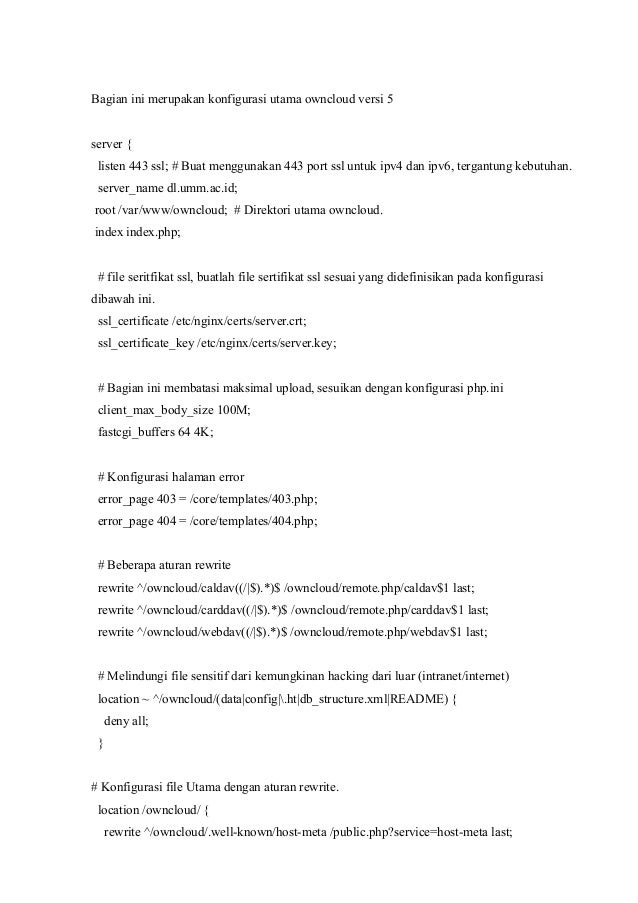

- OWNCLOUD DEFAULT PORT HOW TO
- OWNCLOUD DEFAULT PORT INSTALL
- OWNCLOUD DEFAULT PORT UPDATE
- OWNCLOUD DEFAULT PORT SOFTWARE
- OWNCLOUD DEFAULT PORT PASSWORD
Your Raspberry Pi ownCloud server is now set up and you can start uploading files in the storage by clicking the plus symbol above the list of files and choosing Upload. Take the program’s advice.Īfter all this, you’ll find yourself logged in to the ownCloud web interface. Choose your username and password, then take a look at the apps that ownCloud recommends you download. The setup wizard will prompt you to create an admin account. And the first thing the web interface will do is run the setup wizard. What you’ve types here is the URL for your ownCloud web interface. Remember that IP address for your Raspberry Pi? The one you wrote down? Go ahead and type that in the address bar of your browser between and /owncloud. Hop on another device and open a browser. Let the Pi reboot and then put it aside for a moment. Step 4: Access the ownCloud web interface
OWNCLOUD DEFAULT PORT INSTALL
On the following screen, select OK and hit Enter again to indicate that you’d like to begin.ĭietPi will install ownCloud and then reboot (yes, DietPi really likes to reboot). Navigate to Install – Go > Start installation for selected software and press Enter. You’ll use the space bar to select and Enter to confirm.Īfter selecting ownCloud, you’ll be sent back to the menu you started from.
OWNCLOUD DEFAULT PORT SOFTWARE
In the DietPi menus, navigate to Software Optimized – Select DietPI optimized sogtware for installation and then to 47 OwnCloud: your very own cloud (eg: dropbox).

Once DietPi has rebooted and you’ve logged back in, you’ll be able to install new software – and that’s exactly what we’re going to do. Then log back in! Step 3: Install ownCloud Wait that out and then hit enter to reboot.
OWNCLOUD DEFAULT PORT UPDATE
It’s your first time logging in, so DietPi will update automatically.
OWNCLOUD DEFAULT PORT PASSWORD
Log in with the username root and the password dietpi (you can do this on the Raspberry Pi itself or just SSH in from another computer). We’re going to need that, so go ahead and write it down. DietPi should print out your IP address even before you log in.

With DietPi on the microSD card and your Pi connected to the internet via Ethernet cable, go ahead and boot up. Step 2: Write down your IP address and log into DietPi Grab the disk image here, unzip it with the program of your choice (7-Zip will work), and then write the disk image to your microSD card with the program of your choice (Win32 Disk Imager on PC and Disk Utility on Mac will both work). Your DietPi installation process is the same as with most other Raspberry Pi operating systems. Step 1: Install DietPi on your Raspberry Pi Then we’re going to use ownCloud that works on DietPi. We’re going to install DietPi, a super-lightweight operating system for the Raspberry Pi. You’ll need all the usual stuff plus an Ethernet cable andan external storage device (optional, but recommended – if you’re going to set up ownCloud, you might as well give yourself plenty of storage space). You’re reading The Pi, so you know where this is going: we’re going to use a Raspberry Pi. You’ll just need some storage (like an external hard drive) and a device. You’re more than capable of replicating these services on your own. But you don’t necessarily have to pay money to get reliable cloud storage – and you don’t necessarily have to trust giant companies like Apple with all of your private files. You can turn to services like DropBox or cloud services from major companies like Apple and Google. There are plenty of ways to get cloud storage.
OWNCLOUD DEFAULT PORT HOW TO
How to set up a Raspberry Pi ownCloud server Here’s how to set up a Raspberry Pi ownCloud server. Sounds great, right? So how do you do it? We have you covered. ownCloud is one of the best programs for running a cloud storage system on your Raspberry Pi, and with the help of it and DietPi, it’s easy for any Pi user to have their files at their fingertips anywhere they go. And, thanks to ownCloud, even those of us who don’t trust big companies with our data can enjoy the convenience of cloud storage. You don’t need us to tell you that cloud storage is a very useful thing.


 0 kommentar(er)
0 kommentar(er)
